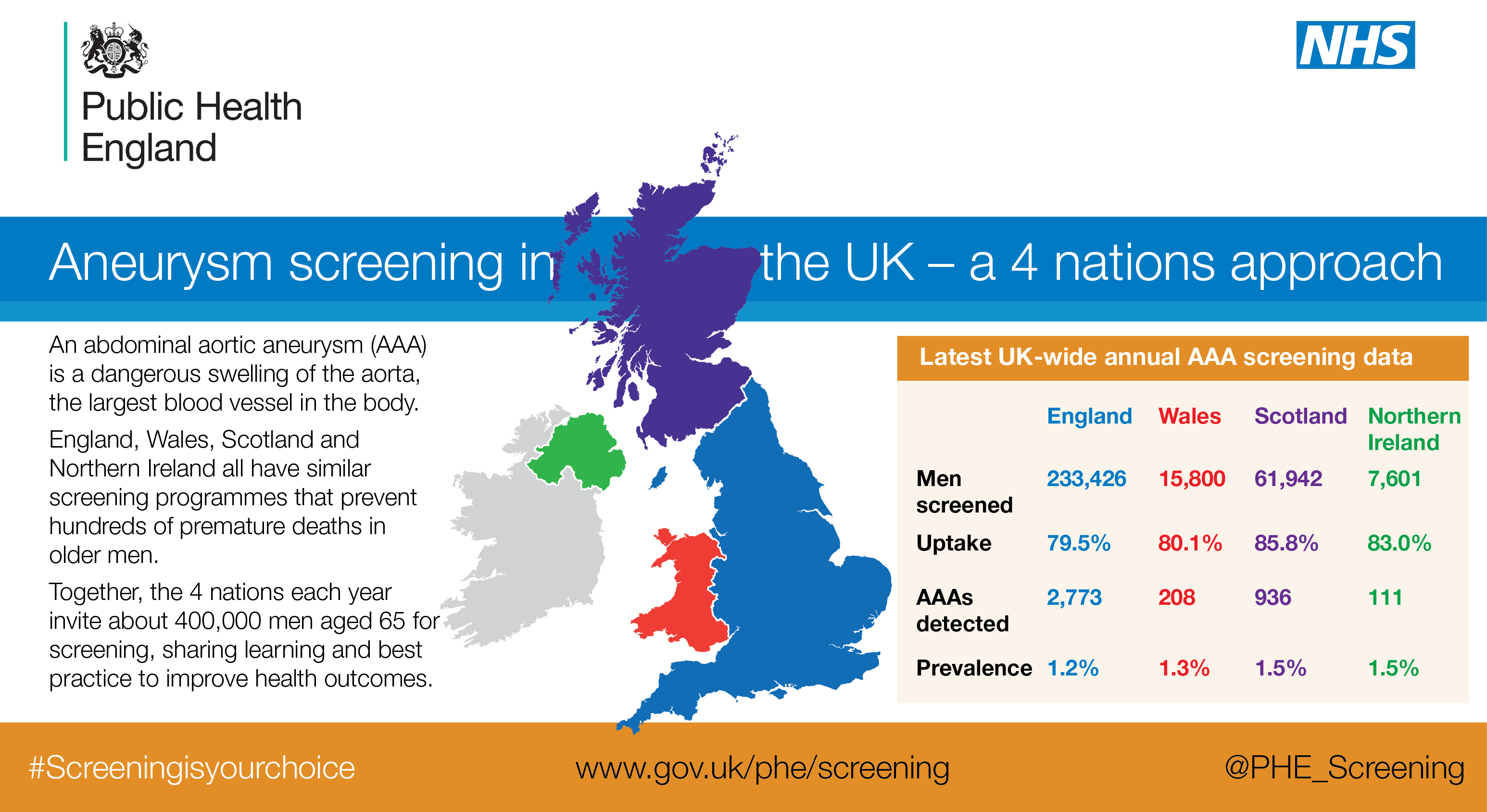There has always been a great deal of collaboration between the 4 UK countries when it comes to learning how best to implement population screening programmes. Abdominal aortic aneurysm (AAA) screening is no exception.
A 4 nations committee meets regularly to discuss AAA screening across the UK. It recently produced a report highlighting screening data from each UK screening programme. This report covers the financial year from 1 April 2014 to 31 March 2015. Similar reports for more recent data are planned. This blog summarises the data, though the full report contains additional notes about how the numbers were calculated.

AAA screening for men in their 65th year has been available across the UK in all 4 nations since April 2014. England, Wales, Scotland and Northern Ireland share the same aim: to reduce AAA-related mortality among men aged 65 and over. Working collaboratively, all 4 nations benefit from shared learning in terms of how to improve the quality of the programmes.
The measurement of the aorta obtained at a man’s screening appointment determines the pathway:
Normal/no AAA (less than 3 cm) – discharged from the programme.
Small AAA (3 cm to 4.4 cm) – added to annual surveillance programme.
Medium AAA (4.5 cm to 5.4 cm) – added to 3-monthly surveillance programme.
Large AAA (5.5 cm or above) – referred to the local vascular service.
April 2014 to March 2015 was the first full year of screening where data was available across all 4 countries. A summary is shown in the table below.
| 2014 to 2015 data | England | Wales | Scotland | Northern Ireland |
| Number of eligible men in their 65th year offered screening | 294,249 | 19,722 | 72,232 | 9,181 |
| Number of men in their 65th year who were screened | 233,426 | 15,800 | 61,942 | 7,601 |
| Uptake of initial screening | 79.5% | 80.1% | 85.8% | 83% |
| Surveillance uptake | 91.0% | 92.1% | N/A | N/A |
| AAA detection rate | 2,773
(1.2%) |
208
(1.3%) |
936
(1.5%) |
111
(1.5%) |
Self-referral
Men over 65 are not invited routinely but can refer themselves for screening by contacting their local programme. Men who self-referred and were subsequently screened are included in the table below.
| 2014 to 2015 data | England | Wales | Scotland | Northern Ireland |
| Number of eligible men over 65 who self-referred and were screened | 24,765 | N/A | 1,393 | 583 |
| Prevalence rate | 2.7% | N/A | 2.7% | 2.6% |
Treatment standards
One of the most important elements of the screening programme is what happens when a man is found to have a large AAA. Programmes must refer these men to treatment centres that follow the Vascular Society for Great Britain and Ireland (VSGBI) framework for improving the results of elective AAA repair. Results against pathways standards are shown below.
| 2014 to 2015 data | England | Wales | Scotland | Northern Ireland |
| Number of men referred for treatment for large AAAs | 687 | 31 | TBC | 22 |
| Timely referral to elective vascular network within one working day for men with AAA > 5.5cm | 99.3% | 96.8% | 99% | 95% |
| Timeliness of intervention - 8 weeks to treatment for those men with AAA > 5cm who are fit for surgery and not declining | 58.6% | 85.2% | TBC | 86% |
| 30 day mortality rate post-surgery | 1.2% | 0% | TBC | 0% |
All 4 countries’ screening programmes are committed to reducing health inequalities. Using available data to ensure equity of access and uptake is a fundamental part of the screening process. It is planned to include this in future reports.
PHE Screening blogs
PHE Screening BLOGs provide up to date news from all NHS screening programmes – replacing our previously published newsletters.
You can register to receive updates direct to your inbox, so there’s no need to keep checking for new blogs.
2 comments
Comment by lynn bayes posted on
My mother died from an AAA - is there any plans for screening women.
Comment by Mike Harris posted on
Dear Lynn,
Sorry to hear about your mother's death. Abdominal aortic aneurysms are much more common in men than women and there is no currently evidence that screening women would meet the UK National Screening Committee's criteria for a population screening programme. However, the NHS AAA Screening Programme is supporting research in Leicester that will try to work out whether some form of targeted screening for women might be an option in future. We expect to see the results of this research in a couple of years' time.